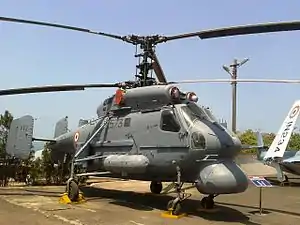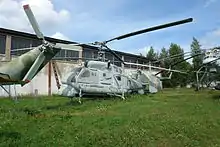Kamov Ka-25
The Kamov Ka-25 (NATO reporting name "Hormone") is a naval helicopter, developed for the Soviet Navy in the USSR from 1958.
| Ka-25 | |
|---|---|
.jpg.webp) | |
| A Soviet Ka-25 anti-submarine helicopter | |
| Role | Anti-submarine / Multi-purpose shipboard helicopter |
| Manufacturer | Kamov |
| First flight | 26 April 1963 (hovering flight) |
| Introduction | 1972 |
| Primary users | Soviet Navy Russian Navy |
| Produced | 1965–1977 |
| Number built | ~460 |
| Developed from | Kamov Ka-20 |
| Developed into | Kamov Ka-27 |
Design and development
In the late 1950s there was an urgent demand for anti-submarine helicopters for deployment on new ships equipped with helicopter platforms entering service with the Soviet Navy. Kamov's compact design was chosen for production in 1958. To speed the development of the new anti-submarine helicopter Kamov designed and built a prototype to prove the cabin and dynamic components layout; designated Ka-20, this demonstrator was not equipped with mission equipment, corrosion protection or shipboard operational equipment. The Ka-20 was displayed at the 1961 Tushino Aviation Day display.
Definitive prototypes of the Ka-25 incorporated mission equipment and corrosion protection for the structure. The rotor system introduced aluminium alloy blades pressurised with nitrogen for crack detection, lubricated hinges, hydraulic powered controls, alcohol de-icing and automatic blade folding. Power was supplied by two free-turbine engines sat atop the cabin, with electrically de-iced inlets, plain lateral exhausts with no infrared countermeasures, driving the main gearbox directly and a cooling fan for the gearbox and hydraulic oil coolers aft of the main gearbox. Construction was of stressed skin duralumin throughout with flush-riveting, as well as some bonding and honeycomb sandwich panels. The 1.5m × 1,25m × 3.94m cabin had a sliding door to port flight deck forward of the cabin and fuel tanks underfloor filled using a pressure refueling nozzle on the port side. A short boom at the rear of the cabin had a central fin and twin toed-in fins at the ends of the tailplane mainly for use during auto-rotation. The undercarriage consisted of two noncastoring mainwheels with sprag brakes attached to the fuselage by parallel 'V' struts with a single angled shock absorber to dissipate landing loads, and two castoring nosewheels on straight shock absorbing legs attached directly to the fuselage either side of the cockpit which folded rearwards to reduce interference with the RADAR, all wheels were fitted with emergency rapid inflation flotation collars. Flying controls all act on the co-axial rotors with pitch, roll and collective similar to a conventional single rotor helicopter. Yaw was through differential collective which has a secondary effect of torque, an automatic mixer box ensured that total lift on the rotors remained constant during yaw maneuvers, to improve handling during deck landings. Optional extras included fold up seats for 12 passengers, rescue hoist, external auxiliary fuel tanks or containers for cameras, flares, smoke floats or beacons.
Variants
- Ka-25BSh
- (NATO reporting name 'Hormone-A') Variants are used in the anti-submarine warfare role, equipped with radar, dipping sonar and a towed MAD and armed with torpedoes and nuclear or conventional depth-charges.
- Ka-25BShZ
- Mine-sweeping version, eight built.[1]
- Ka-25C
- Little-known upgrade.
- Ka-25F
- Proposed assault version in competition with the Mi-22 and the larger Mi-24. Modified with a glazed nose, cargo compartment with four doors, an under-fuselage turret with a GSh-23L and provision for up to six 9M17 Phalanga Anti-tank missiles or six UB-16 rocket launchers, each with 16 S-5 rockets or bombs.
- Ka-25K
- (NATO reporting name 'Hormone-B') Over The Horizon targeting version for relaying data to cruise missiles launched from surface warships and submarines. Anti-submarine equipment, Electronic Surveillance Measures and weapons bay removed and larger radar scanner/reflector in a bulged radome under the nose. Also recognisable by a small cylindrical data-link antenna under the rear fuselage.

- Ka-25K
- Civilian flying crane helicopter with a gondola under the lengthened nose for controlling slung loads up to 2,000 kilograms (4,400 lb). Fitted with electrically de-iced rotor blades and optional seats for 12 passengers. A single prototype (SSSR-21110) flown in 1966
- Ka-25PS
- (NATO reporting name 'Hormone-C') Search and rescue and transport version with no weapons bay, radome as Ka-25BSh. Normal equipment included seats for 12, rescue winch, provision for stretchers and auxiliary tanks. Optional equipment included a homing receiver, Electronic Surveillance Measures, searchlight and loudspeaker. Ka-25PS helicopters were usually painted red and white.
- Ka-25T
- (NATO reporting name 'Hormone-B'): Possibly misidentified or incorrect designation for Ka-25K OTH targeting relay aircraft.
- Ka-25TL
- Missile tracking version. Also known as the Ka-25TI and Ka-25IV.
Operators

Current operators
Former operators

Specifications (Ka-25BSh)
Data from [10]
General characteristics
- Crew: 4
- Length: 9.75 m (32 ft 0 in)
- Height: 5.37 m (17 ft 7 in)
- Empty weight: 4,765 kg (10,505 lb)
- Gross weight: 7,500 kg (16,535 lb)
- Powerplant: 2 × Glushenkov GTD-3F turboshaft, 671 kW (900 hp) each
- Main rotor diameter: 2× 15.74 m (51 ft 8 in)
- Main rotor area: 389.2 m2 (4,189 sq ft) contra-rotating 3-bladed rotors
Performance
- Maximum speed: 209 km/h (130 mph, 113 kn)
- Cruise speed: 193 km/h (120 mph, 104 kn)
- Range: 400 km (250 mi, 220 nmi)
- Service ceiling: 3,350 m (10,990 ft)
Armament
- 1,900 kg (4,189 lb) of disposable stores
See also
Related development
Aircraft of comparable role, configuration, and era
Related lists
References
Notes
- Taylor 1996, p. 316
- "World Air Force 1987 pg. 91". flightglobal.com. Retrieved 5 April 2013.
- "World Air Forces 1991 pg. 38". flightglobal.com. Retrieved 5 April 2013.
- "World Air Forces 2013" (PDF). Flightglobal Insight. 2013. Retrieved 7 April 2013.
- "World Air Forces 2001 pg. 66". flightglobal.com. Retrieved 5 April 2013.
- "World Air Force 1987 pg. 86". flightglobal.com. Retrieved 5 April 2013.
- "World Air Forces 2001 pg. 73". flightglobal.com. Retrieved 5 April 2013.
- "World Air Force 1987 pg. 105". flightglobal.com. Retrieved 5 April 2013.
- "World Air Force 1987 pg. 67". flightglobal.com. Retrieved 5 April 2013.
- Gunston, Bill. “The Osprey Encyclopaedia of Russian Aircraft 1875–1995”. London, Osprey. 1995. ISBN 1-85532-405-9 and Chant, Cris. "Warships Today". New York, Barnes & Noble Books. 2004. ISBN 0-7607-6700-9
Bibliography
- Gunston, Bill. “The Osprey Encyclopaedia of Russian Aircraft 1875–1995”. London, Osprey. 1995. ISBN 1-85532-405-9
- Taylor, Michael J. H. (1996). Brassey's World Aircraft & Systems Directory. London, England: Brassey's. ISBN 1-85753-198-1.
External links
| Wikimedia Commons has media related to Kamov Ka-25. |
